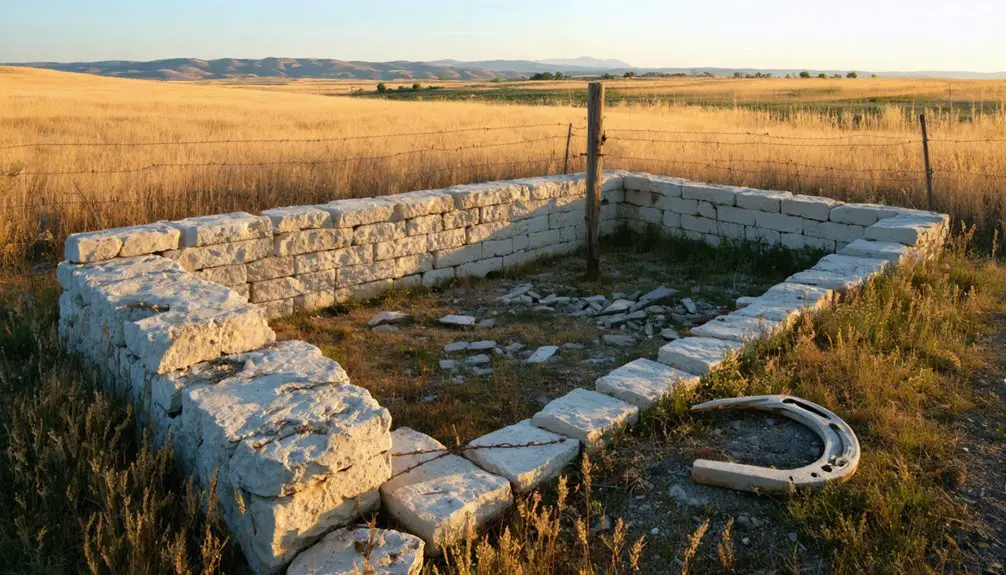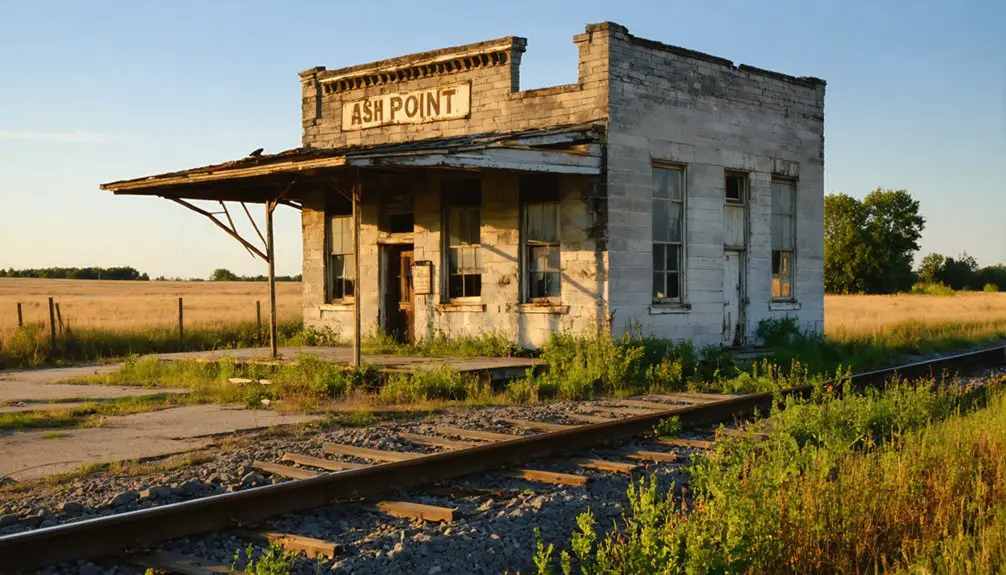You’ll find Ash Point’s remarkable story began in 1857 when pioneers Josiah Blancett and John Short established this essential waypoint on the Fort Leavenworth-Fort Laramie Military Road. The settlement quickly grew into a bustling hub featuring “Uncle John’s Grocery,” a hotel, and an important Pony Express station. Though the town declined after 1870 when its post office closed, its rich frontier legacy of stagecoaches, mail routes, and cultural exchange between settlers and Native Americans holds fascinating secrets.
Key Takeaways
- Established in 1857 along the Fort Leavenworth-Fort Laramie Military Road, Ash Point served as a crucial frontier waypoint and stagecoach stop.
- The town centered around “Uncle John’s Grocery” and hotel, which operated as a Pony Express station and Overland Stage Route hub.
- Ash Point thrived during the 1850s-1860s as a bustling community serving soldiers, gold seekers, and emigrants traveling westward.
- Political tensions from the Kansas-Nebraska Act and shift toward free-state status led pro-slavery residents to abandon the settlement.
- The town’s decline culminated with the closure of its post office in 1870, leaving only archaeological remnants of frontier life.
The Birth of a Strategic Frontier Settlement
When the Fort Leavenworth and Fort Laramie Military Road needed a strategic waypoint in 1857, settlers established Ash Point at S8 T2S R11E in Kansas Territory.
The settlement dynamics quickly took shape as pioneers Josiah Blancett and John Short set up homes, while “Uncle John’s Grocery” and a hotel formed the town’s commercial heart. Like many settlements of the era, Ash Point emerged during a time when French fur trappers had already established trade networks with local tribes.
You’ll find Ash Point’s significance grew as it served multiple roles during frontier conflicts. Known variously as Laramie Creek Station, Frogtown, and Hickory Point, the settlement became crucial to westward expansion. The location gained prominence as a Pony Express Station where travelers could rest and resupply.
Life Along the Military Road
As travelers ventured along the Fort Leavenworth-Fort Laramie Military Road in the 1850s and 1860s, they’d find Ash Point bustling with a mix of soldiers, gold seekers, and emigrants.
At Uncle John’s Grocery and hotel, you’d witness the dynamic community rhythm as stagecoaches rolled in, carrying mail and weary passengers ready for a hot meal and rest. These coaches were part of a vast network that spanned 1,913 miles total, connecting countless frontier communities. The area’s rich wild plums and grapes provided welcome sustenance for weary travelers.
Stagecoaches thundered into Uncle John’s, bringing dusty travelers seeking refuge from the trail’s relentless demands.
Military logistics shaped daily life, with these key services available:
- Stage and Pony Express operations for swift communication
- Lodging and meals priced from fifty cents to two dollars
- Essential supplies at O’Laughlin’s store
- Mail service through the local post office
The pro-slavery settlement‘s prominence gradually faded as Kansas emerged Free State, but it remained a crucial stop for those seeking fortune and freedom out West.
From Pony Express to Stage Stop
At Ash Point’s Pony Express station before 1860, you’d find John O’Laughlin managing fresh horse exchanges and resupplying riders along the Central Overland California & Pikes Peak Express Co. route.
You could later witness the station’s evolution into a bustling stagecoach stop, complete with separate sleeping quarters for men, women, and children in the hotel. This venture was run by founders who managed 6,000 employees across their business empire.
After only 18 months of operation, the Pony Express ended when telegraph lines were completed in October 1861.
Early Express Station Operations
The bustling frontier station of Ash Point emerged in 1857 along the Fort Leavenworth and Fort Laramie Military Road, quickly becoming an important link in Kansas’s early transportation network.
You’d find John O’Laughlin managing the operation, which included “Uncle John’s Grocery” and a hotel serving weary Pony Express riders and settlers alike. The station was strategically positioned on Vermillion Creek, providing an ideal rest stop for travelers.
As the last Kansas station before crossing into other territories, Ash Point provided essential support for rider experiences through:
- Fresh horses for quick exchanges
- Food and rest facilities for exhausted riders
- Important supplies like clothing and provisions
- Safe haven during dangerous frontier conditions
Despite the harsh environment and threat of Indian attacks in 1860, the station maintained its significant role in keeping mail moving westward, later evolving to serve stagecoach travelers on the Overland Route. The station’s efficiency helped achieve the remarkable feat of delivering mail in ten days or less from coast to coast.
Overland Stage Route Evolution
While the Pony Express brought revolutionary speed to mail delivery through Ash Point in 1860, its change to an Overland Stage stop marked an even more significant alteration in frontier transportation.
You’ll find that Ben Holladay’s Overland Mail Stage Line strategically incorporated Ash Point’s express station into its expanding network, improving route efficiency through the region. The shift allowed for heavier loads and more all-encompassing mail logistics than the lightweight Pony Express system could handle. Riders typically covered 75 miles per day as they moved between stations, maintaining strict schedules.
As stage operations grew, Ash Point evolved from a simple relay point to a bustling home station, supporting both mail transfer and passenger services. Similar to the Pony Express stations that were placed every 10-15 miles along the route, the stagecoach system maintained regular stopping points for fresh horses and supplies.
The station’s infrastructure expanded to accommodate longer stays, multiple horse teams, and increased provisions – a pattern you’d see repeated across the frontier as stagecoach services replaced the short-lived Pony Express.
The O’Laughlin Legacy
You’ll find John O’Laughlin’s influence at Ash Point centered around “Uncle John’s Grocery” and his hotel, which formed the heart of local commerce in the late 1850s.
His establishment served both as an essential rest stop for weary travelers and a social hub where stage passengers could purchase whiskey during their brief layovers.
Through his business acumen, O’Laughlin transformed a simple junction on the Fort Leavenworth and Fort Laramie Military Road into a thriving commercial center that supported both local residents and passing travelers.
Uncle John’s Business Empire
Pioneer entrepreneur John O’Laughlin transformed Ash Point’s economic landscape in 1857 when he established “Uncle John’s Grocery” along Vermillion Creek. His entrepreneurship created a crucial hub combining retail, lodging, and transportation services at this strategic location.
You’ll find O’Laughlin’s community impact reached far beyond simple commerce, as he supported struggling settlers through tough times.
Key elements of O’Laughlin’s business empire included:
- Operating the Pony Express station and providing essential services to travelers
- Extending credit to help settlers avoid selling their land
- Expanding into successful ranching operations across Kearny County
- Creating employment opportunities for local residents on his ranches
His pioneering spirit and commitment to neighbors’ welfare earned him posthumous recognition in the 1935 Kearny County Hall of Fame, cementing his legacy as a cornerstone of regional development.
Hotel and Whiskey Trade
Building upon his grocery store success, John O’Laughlin expanded his business interests in 1857 by opening a hotel alongside “Uncle John’s Grocery” near Vermillion Creek.
You’d find his establishment serving multiple roles – a rest stop for weary travelers, a Pony Express relay station, and an essential hub along the Overland Stage Route.
O’Laughlin’s venture into frontier hospitality services included a thriving whiskey trade that drew stage passengers and locals alike. His stone-covered well provided fresh water, while his whiskey culture helped establish the hotel as a lively social center.
The hotel effectively doubled as both a community gathering place and a significant logistics point during America’s westward expansion. Despite the town’s small size, O’Laughlin’s hotel-and-whiskey enterprise anchored Ash Point’s commercial activity throughout the 1850s and 1860s.
Political Tensions in Early Kansas Territory

When the Kansas-Nebraska Act introduced popular sovereignty in 1854, it sparked intense political tensions that would transform Kansas Territory into a violent battleground over slavery.
You’d witness an unprecedented wave of political migration as both pro-slavery Missourians and northern abolitionists flooded into the territory, each determined to shape Kansas’s future.
The territory’s early elections revealed widespread voter fraud, particularly in towns like Leavenworth where:
- Missouri “border ruffians” crossed illegally to cast votes
- Vote counts exceeded actual population numbers
- Pro-slavery candidates won 90% despite anti-slavery majority
- Free-Staters formed a rival government in protest
This political struggle led to the establishment of competing governments, with President Pierce’s recognition of the pro-slavery “Bogus Legislature” further inflaming tensions between the opposing factions.
Daily Life and Commerce on the Trail
Life along the Fort Leavenworth-Fort Laramie Military Road centered around bustling stops like Ash Point, where travelers found essential services after 1857.
You’d discover “Uncle John’s Grocery” and a well-appointed hotel offering segregated sleeping quarters and a vibrant dining hall that doubled as a dance space. Your traveling experiences would include paying 50 cents to $2 for meals, while O’Laughlin’s informal whiskey sales kept spirits high.
Community interactions flourished as Pottawatomie tribes made seasonal camps nearby, creating a dynamic social environment. You’d stable your horses in the large barn while mingling with Pony Express riders and fellow stage passengers.
The post office connected you to the wider world, while the town’s position as the first water source after Seneca made it an indispensable noon stop for weary travelers.
Transportation Hub of the West

Founded in 1857 at the crossroads of major westward routes, Ash Point emerged as an essential transportation nexus in Nemaha County, Kansas.
You’d find this bustling frontier commerce hub connecting crucial transportation networks including the Pony Express, Oregon Trail, and Fort Leavenworth-Fort Laramie Military Road.
At Ash Point’s peak, you could access:
- A well-equipped hotel featuring separate sleeping quarters for men, women, and children
- Large stables housing horses and mules for Pony Express riders
- Multiple storage sheds stocked with grain and hay
- Reliable water wells – the first since leaving Seneca
The town’s strategic position, about 10 miles northwest of Seneca, made it indispensable for westward expansion until 1872, when railroad construction through Axtell diverted traffic away from this once-thriving stop.
The Final Years of a Frontier Town
As Kansas moved toward free-state status in the 1860s, Ash Point’s pro-slavery population began abandoning the once-bustling frontier station.
You’d have witnessed the town’s steady decline as essential businesses closed their doors and residents sought opportunities elsewhere.
During its final years, the loss of the post office in 1870 marked a critical turning point – Clear Creek now handled the mail service that had been central to Ash Point’s community life.
Archaeological Remnants and Historical Preservation

Located at the heart of S8 T2S R11E along the Fort Leavenworth and Fort Laramie Military Road, Ash Point’s archaeological remnants tell a rich story of frontier life and cultural shifts.
Recent archaeological surveys have uncovered evidence spanning thousands of years, from prehistoric hunter-gatherer settlements to 19th-century Pony Express operations.
Today’s preservation challenges include:
- Erosion threatening surface artifacts
- Limited documentation of existing sites
- Overgrowth concealing structural remains
- Lack of standing architecture
You’ll find burnt clay deposits, ceramic fragments, and stagecoach-era artifacts scattered throughout the area, while nearby ghost towns like Clements demonstrate successful preservation efforts.
Local communities can help protect these valuable historical resources through site monitoring, education programs, and support for protective legislation, ensuring Ash Point’s frontier legacy endures for future generations.
Frequently Asked Questions
What Native American Tribes Originally Inhabited the Ash Point Area?
You’ll find the Kanza (Kaw) tribe primarily inhabited this land, establishing major villages nearby, while Native tribes like the Shawnee, Pottawatomie, and Osage shared the cultural heritage of this region.
How Many People Lived in Ash Point During Its Peak Population?
While you’d see population dynamics similar to other Kansas mining towns, historical significance suggests Ash Point likely peaked at 200-300 residents in the early 1900s before declining with mining’s end.
Were There Any Notable Crimes or Shootouts in Ash Point?
As silent as a ghost town itself, you won’t find documented crime history or shootout incidents in Ash Point’s records, despite its location along risky stagecoach routes during the 1850s-1870s.
What Happened to John O’laughlin After Ash Point Was Abandoned?
You won’t find clear records of John O’Laughlin’s fate after Ash Point’s decline. Historical documents fall silent on his later years, leaving his story unfinished once the town’s bustling days ended.
Did Any Famous Historical Figures Pass Through Ash Point?
Like footprints in shifting sand, records don’t show any famous visitors passing through. While countless pioneers and stagecoach travelers used this stop, its historical significance lies in everyday westward movement.
References
- https://legendsofkansas.com/nemaha-county-kansas-extinct-towns/
- http://www.kansasheritage.org/werner/gostnmco.html
- http://www.ksgenweb.org/archives/1912/e/extinct_towns.html
- https://thewanderingpigeon.com/2015/10/03/day-of-kansas-ghost-towns/
- https://legendsofkansas.com/marshall-county-extinct-towns/
- https://lostkansas.ccrsdigitalprojects.com/sites/lostkansas/files/private_static/2022-12/LT_NM_AmericaCity_Hermesch.pdf
- https://en.wikipedia.org/wiki/History_of_Kansas
- https://www.kspatriot.org/index.php/articles/16-territorial-kansas/624-kansas-and-the-indian-frontier.html
- https://legendsofkansas.com/nemaha-county-kansas/
- https://usgenealogyresearch.atwebpages.com/Kansas/Nemaha/misc_history_1912.pdf



